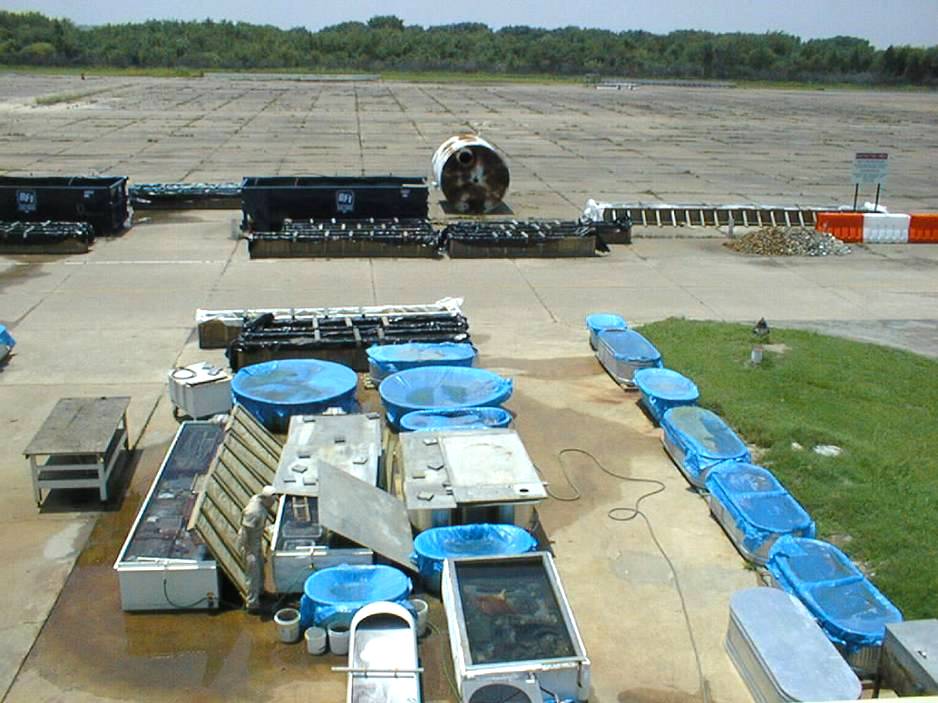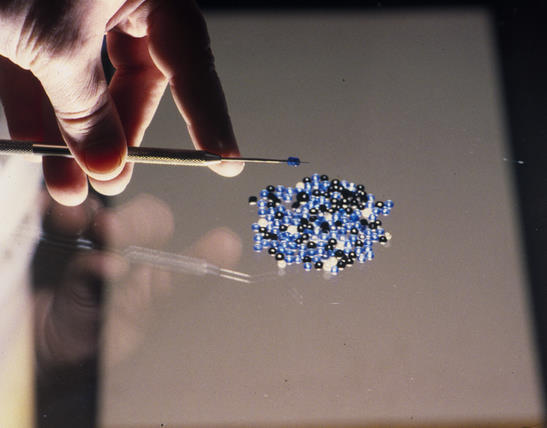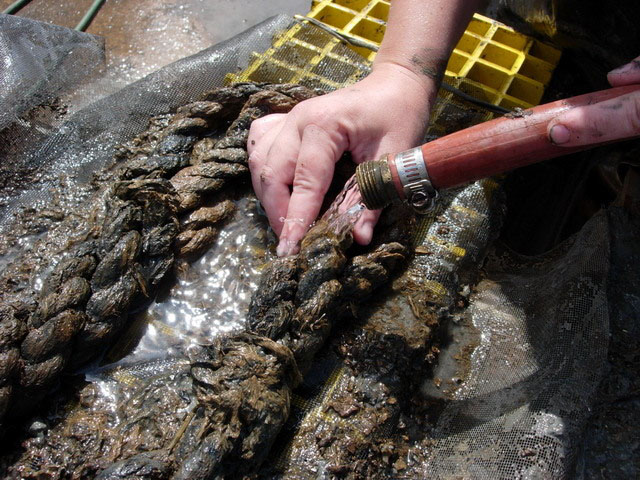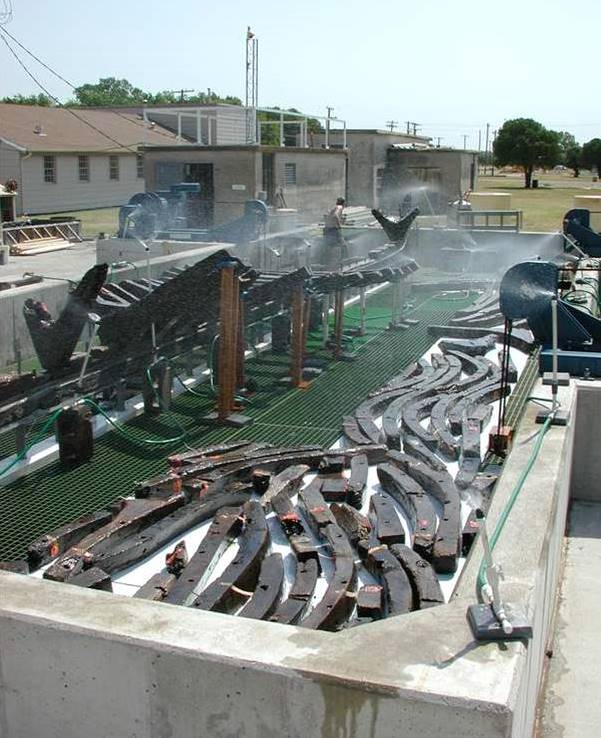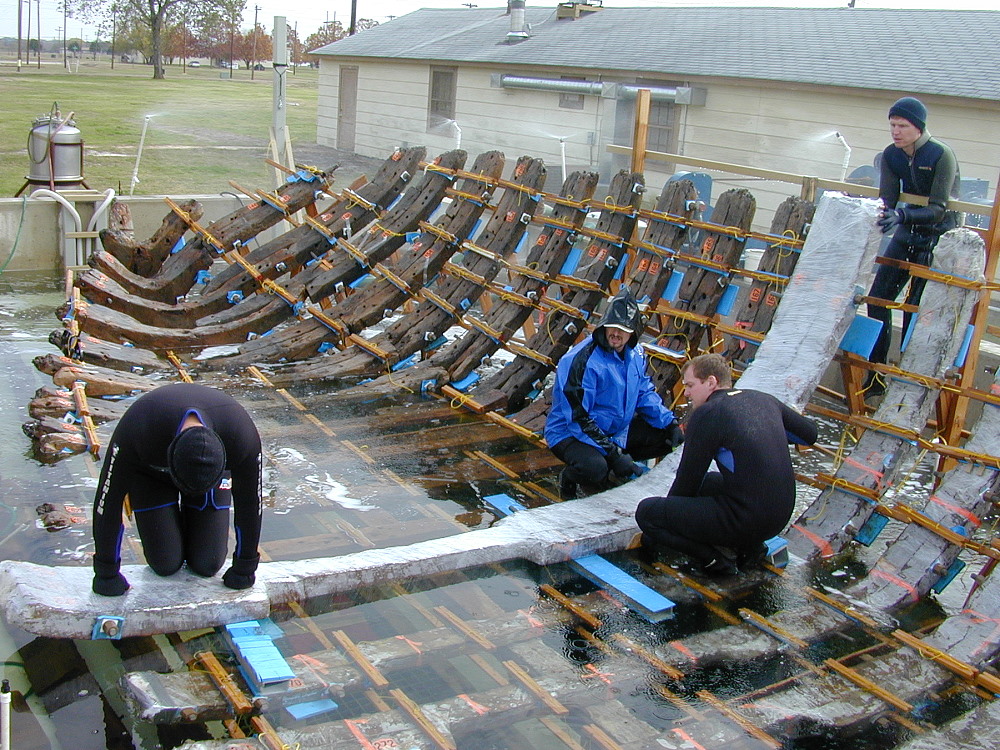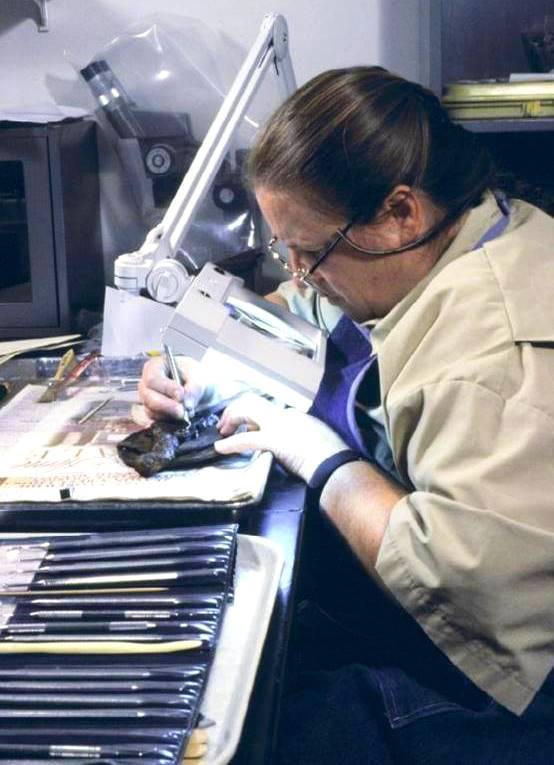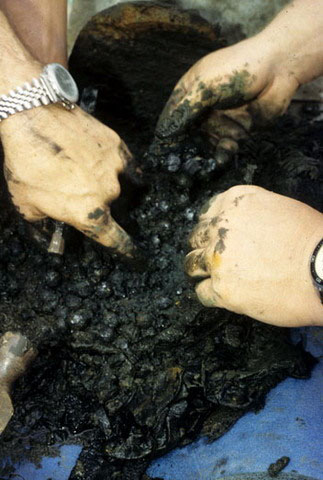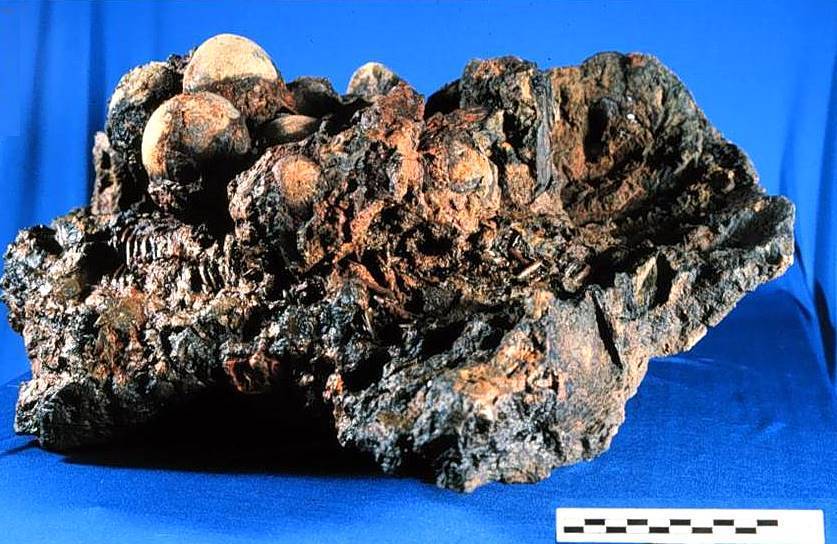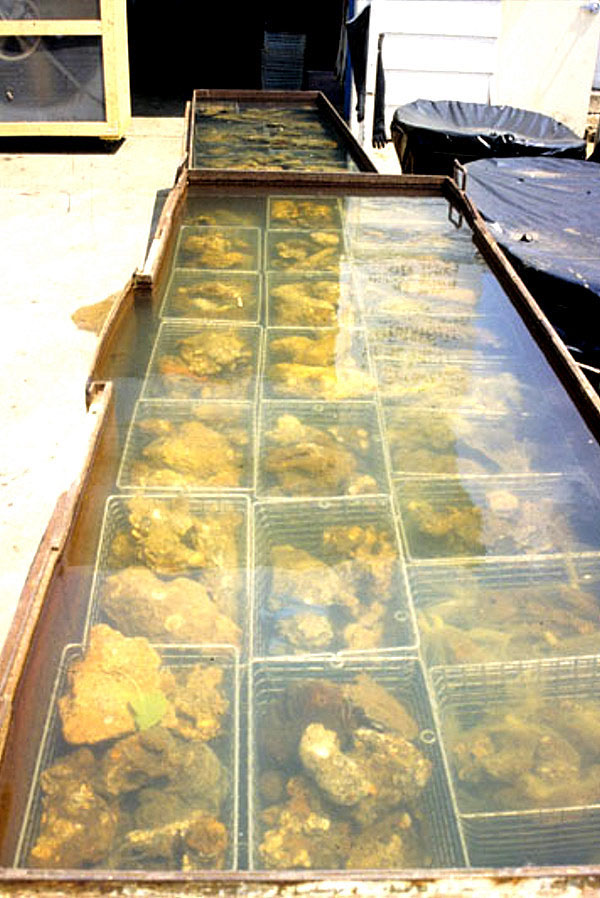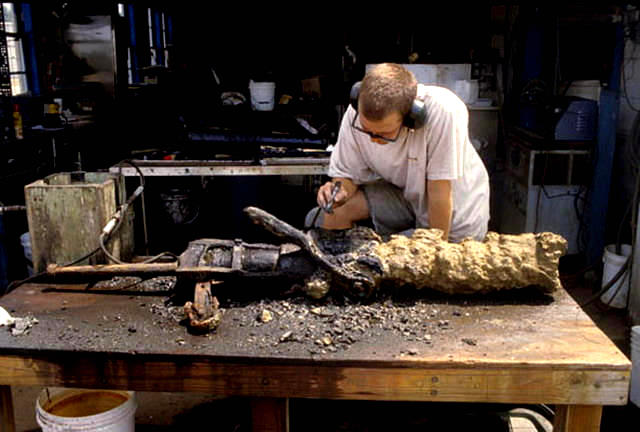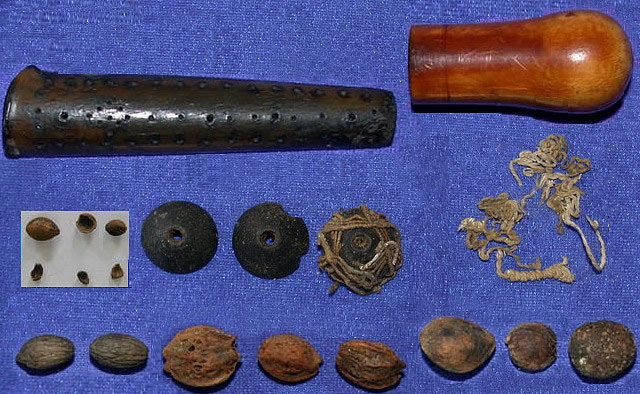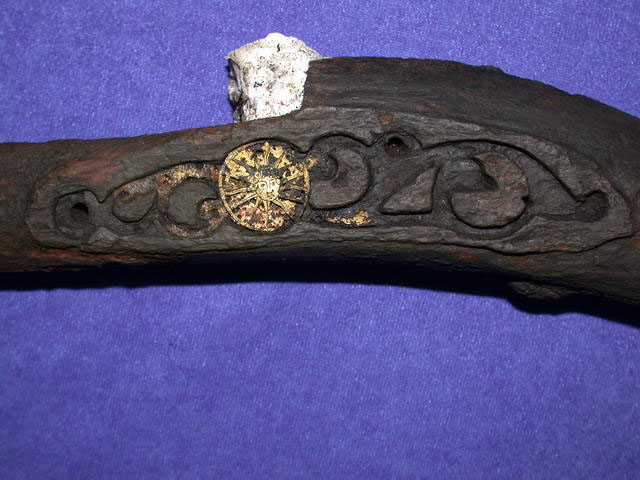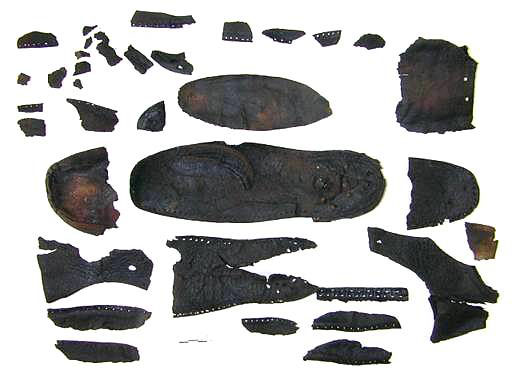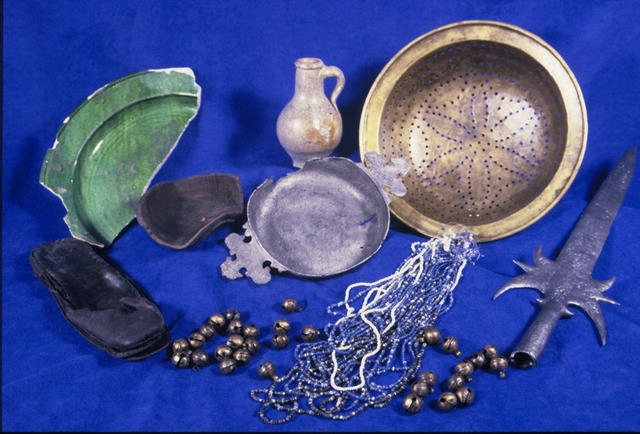"Excavations" in the Laboratory
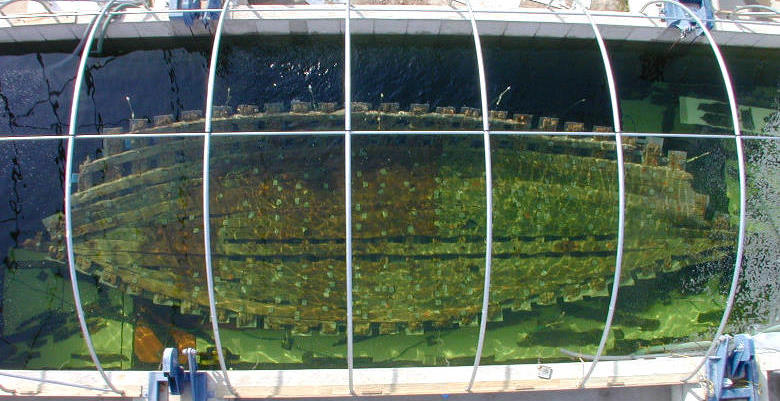
The reassembled hull of La Belle rests in its special vat filled with conservation chemicals. The fragile vessel still has to absorb more of the chemical solution to stabilize the wood. Then it will be slowly reintroduced to the natural environment and air dried. |
|
The hull is still several years from being fully treated, as the wood has to absorb a substantial portion of the conservation chemical. Once that threshold has been achieved then excess chemicals will be pumped out and very slowly/gradually/carefully allow any excess to drain out while the hull is air dried. During this period the timbers will be cleaned of excess chemical and debris. Once the wood is dried, stable and strong, then the lab crews will begin the systematic disassembly of the ship for transport and eventual reassembly for display in the Bob Bullock State History Museum in Austin. While the actual hull has been undergoing conservation, a 1/12-scale model of the Belle also was being constructed. Both the ship and model were used for teaching nautical archeology classes. Another model, destined for the Rockport Maritime Museum on the Texas coast, was constructed by model builder Glenn Greico—a process spanning three years. (A model of La Belle also was built in Paris and is now on display at the Maritime Museum of the Louvre Museum system.) Uncovering the ArtifactsOnce the last of the artifacts had arrived at the lab, Dewolf and Hamilton were better able to assess what was needed to manage the processing, analysis, and treatment strategies for such a large quantity of artifacts of such different materials. As Dewolf noted, "This was not a matter of processing a single artifact at a time, but literally thousands!" Each artifact would have to be handled, cleaned, examined, conserved, drawn, photographed, documented and stored before, during and after conservation. There was also considerable research into historic documents and comparative collections to help identify a number of the more unusual objects. Time, space, and funding were a constant concern. According to Dewolf, there is a general rule of thumb for conserving artifacts from underwater sites. Under the best of all circumstances, for every month spent excavating in the field it takes at least a year in the conservation lab. Given that it was anticipated that the La Belle recovery would entail little more than a ballast pile, concretions, and a few small organic remains under the ballast pile, the excavation was planned to take approximately 5 months and thus the conservation, 5 years. As it turned out, the field excavation took approximately 9 months, meaning researchers needed to allow for at least 9 years in the conservation lab. That "rule," Dewolf notes, never took into account the conservation of an entire ship's hull or the enormous quantity of organic material found inside the cargo holds, which was not anticipated. Conservation on an Unprecedented ScaleConservation on the scale required by the material culture assemblage excavated from La Belle is rarely seen. Some artifacts were composed of several different materials and thus required more than one conservation treatment. Among these "composite" artifacts were such distinctive items as polearms, weapons with pointed iron blades attached to long wooden shafts. There were also tools with wooden handles, muskets with wood, brass, and iron elements, and other objects of varied constituents. One wooden chest, dubbed "the Mystery Chest" because of its odd contents, contained a variety of composite tools for farming, fishing, wine making, and coopering. (For more detail, see "Uncovering the Mystery Chest" in the section, Treasures of La Belle.) Other artifacts needed extra care because of their fragile state of preservation. The very simplest process required an artifact to be cleaned and rinsed (to remove the chlorides/salts), then air-dried and documented. This process was used on ballast, slate and gun flints. Ceramics, and galley bricks required the additional steps of dehydration, consolidation, and reassembly to the basic process. The metal artifacts underwent three types of treatment. Those in better condition were treated with electrolytic reduction (ER), which reduces the corrosion products on the surface of the metal back to a metallic state, forces the chlorides from the material, and physically removes some corrosion products and concretion from the surface of the metal. The more fragile metals underwent a chemical treatment to accomplish the same effects as ER without the potentially destructive evolution of the hydrogen bubbles. After these treatments the metal artifacts were boiled to remove the last of the residual chlorides, then chemically sealed and treated to prevent future corrosion. "Excavating" Concretions |
|
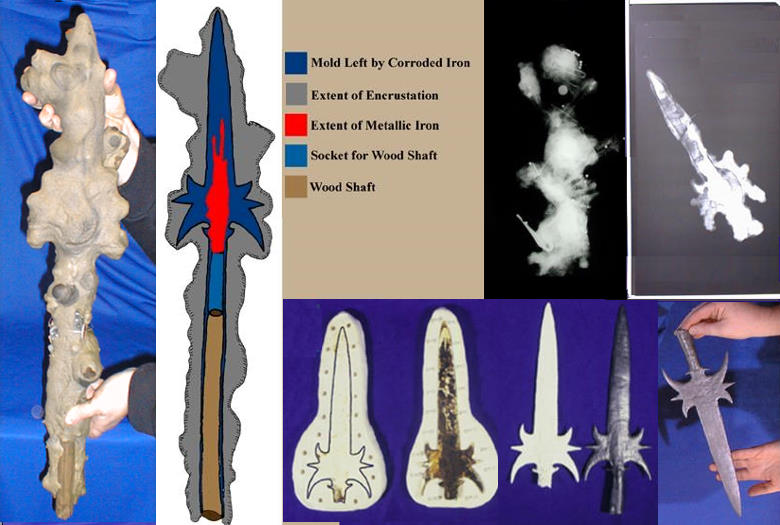 Polearms, archaic weapons made of wood poles with pointed iron blades, were among the numerous composite artifacts from La Belle requiring special conservation treatments. Covered with thick layers of marine encrustations, the objects had to be x-rayed to determine how much metal remained inside and what types of treatment were necessary. As shown in the graphic above and x-ray image on the top row (second from right), there was little intact metal remaining in this polearm. Its hollow interior was cleaned out and filled with epoxy (image top right). A perfect cast of the original thus was created.
|
|
Some metal artifacts-primarily those made of iron-were found covered in what is known as concretion, a multilayered covering of calcareous mineral deposits and corrosion products that formed on the surface of the artifact as the material corroded underwater. When a metal object is immersed in saltwater, a layer of marine encrustration almost immediately begins to form. In many instances, the iron completely corrodes away over time and the concretion forms a natural mold of the original object. This mold was cleaned out and an epoxy resin poured inside to make an exact cast of the original. Often, X-rays of the artifacts indicated that not all of the original iron had corroded away. In these instances, the hollow area of the mold where there was no iron was cleaned out and epoxy poured into the void. The concretion was then removed from the surface of the artifact, a mold made of the whole object, and a cast made of the now composite object. From Ribbons to Rope: Preserving OrganicsAn extraordinary variety of organic materials also was discovered among the remains of the shipwreck. These included artifacts made of leather, wood, and textiles. There were fragments of paper as well as the remains of baskets, and coils of rope. Excavations in the lab even revealed food supplies or perhaps the remains of meals served on board the ship. Some of the animal bones, seeds and nuts represented foods brought from France; others, including bits of cactus seed, clearly had been gathered locally and brought on board by shore parties. The smaller organic artifacts were treated using polymer passivation polymers, an innovative technology that allows for better long-term preservation of the artifacts and future retreatment if necessary. Developed at the Texas A&M Archaeological Preservation Research Laboratory (APRL) by C. Wayne Smith, this technology enabled conservators to streamline the dehydration, immersion and catalyzation steps of the conservation process of organic materials and thus process multiple artifacts of differing sizes and materials at the same time. This made the process of treating artifacts efficient in terms of time, chemicals, space, hands-on manipulation by the conservation lab staff, documentation, photography, etc. The chemical nature of the polymer treatment allowed the lab crew to devise a schedule that accommodated the divergent materials found on La Belle. The passivation polymers technology works on the cellular level of the material and, once impregnated, all organics are treated on a cell by cell basis. The largest and densest materials were used as a guide for the treatment schedule. The smaller, less dense materials were never adversely affected by being in treatment for a prolonged schedule. Once the polymer was introduced into the cell of the material no more could be forced in to distort the cell. Other practical considerations came into play with the larger quantities of organic materials, including approximately 300 feet of bow rope, 75 wooden casks and the hull itself. Because the cost of solvents and chemicals for the polymer treatment (not to mention risk of flammability) was prohibitive, a conservation strategy using Poly Ethylene Glycol (PEG) was used. For efficiency of space and materials, some of the remaining wood casks were conserved with the hull in the same vat. The rope was conserved using PEG as well but needed a shorter immersion timetable. This required large vats dedicated specifically to the rope treatment. Funded by the THC, private donors, and foundations, the conservation of La Belle and its myriad treasures has spanned nearly nine years. Because of innovations in organic conservation technologies and strategies and a group of graduate students working part-time and volunteering to aid the three full-time conservators, the CRL lab and the THC successfully conserved approximately 95% of the total number of artifacts from La Belle. This includes : several hundred feet of rope in lines and coils; 45 wood rigging pieces; almost 1800 small wood finds including 200+ wood knife handles; 100+ wood buttons; 24+ wood combs; 770,690 glass beads; 1038 shards of other glass; 1413 pieces of leather; 366 pieces of textile; ); 1786 seeds & floral material; 2071 bones/faunal material and insects; 19,743 brass objects including 5,000+ brass straight pins; 1500+ brass rings; 1000+ brass bells and 3 bronze cannon; 180+ Pewter objects; 700+ pieces of ceramic and brick; 675+ iron axe heads; 1 swivel gun; 1344+ concretions containing a minimum of 2133 artifacts; 209,584 lead shot and one box containing 59 artifacts including tools and miscellany. More remains to be conserved, and the THC has raised additional funds to complete the task. According to Dewolf, "We are down to the last 75 casks and barrels, 8 boxes; 19 swords; 32 muskets;156 priority concretions and 1076 non-priority concretions; a couple of hundred feet of rope and the hull itself—almost all of which have started but not yet finished conservation treatments." The remains from La Belle constitute one of the largest collections of 17th-century French artifacts ever excavated in the New World. Several of these artifacts are now on display for the public at the Bob Bullock State History Museum in Austin and the six La Salle Odyssey museums along the Texas coast. In the near future, La Belle's hull will travel to its final destination, to be permanently displayed in the State History Museum. (To view more examples of artifacts see the section, Treasures of La Belle.) |
|
